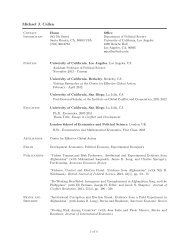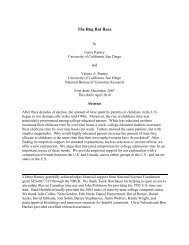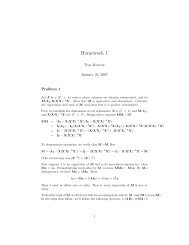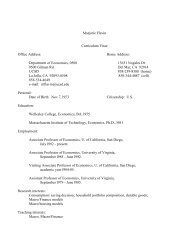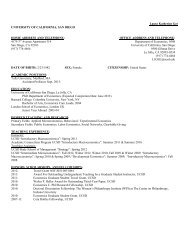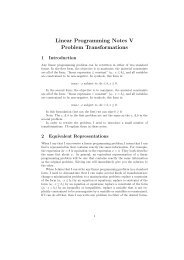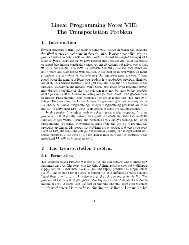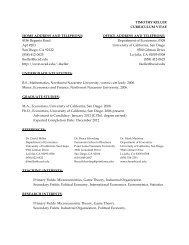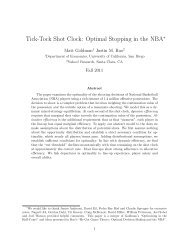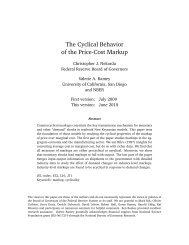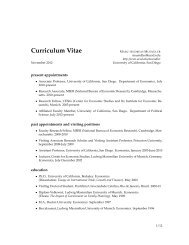Endogenous derivation of 'money' - UC San Diego Department of ...
Endogenous derivation of 'money' - UC San Diego Department of ...
Endogenous derivation of 'money' - UC San Diego Department of ...
You also want an ePaper? Increase the reach of your titles
YUMPU automatically turns print PDFs into web optimized ePapers that Google loves.
470 R. M. Starr<br />
function. But the government is uniquely capable <strong>of</strong> declaring it acceptable in<br />
payment <strong>of</strong> taxes. Adam Smith (1776) notes “A prince, who should enact that a<br />
certain proportion <strong>of</strong> his taxes be paid in a paper money <strong>of</strong> a certain kind, might<br />
thereby give a certain value to this paper money...” (v. I, book 2, ch. 2). Abba<br />
Lerner (1947) comments, “The modern state can make anything it chooses generally<br />
acceptable as money...if the state is willing to accept the proposed money in payment<br />
<strong>of</strong> taxes.”<br />
Taxation – and fiat money’s guaranteed value in payment <strong>of</strong> taxes – explains the<br />
positive equilibrium value <strong>of</strong> fiat money. 7 Scale economies explain its uniqueness<br />
as the medium <strong>of</strong> exchange.<br />
As an economic agent, government is denoted G. Government sells tax receipts,<br />
the N +1 st good. It also sells good N +2, an intrinsically worthless instrument,<br />
(latent) fiat money, that government undertakes to accept in payment <strong>of</strong> taxes, that is,<br />
in exchange for N +1. The typical household [m, n] in H 1 or H κ desires to purchase<br />
tax receipts to the extent it prefers not to have a quarrel with the government’s tax<br />
authorities. Government sets a target tax receipt purchase by the taxayer <strong>of</strong> τ [m,n] .<br />
Then we rewrite [m, n]’s utility function as:<br />
u [m,n] (x) =<br />
N<br />
i=0,i=n<br />
xi +3xn − 10[max[(τ [m,n] − x [m,n]<br />
N+1 ), 0]] (UT)<br />
That is, household [m, n] values paying his taxes with a positive marginal utility<br />
up to his tax bill τ [m,n] and with zero marginal utility for tax payments thereafter.<br />
Government uses its revenue to purchase a variety <strong>of</strong> goods n =1, ..., N, inthe<br />
amount x G n .<br />
Good N +2good represents latent fiat money. Government, G, sells N +1(tax<br />
receipts) for N +2at a fixed ratio <strong>of</strong> one-for-one. The trading post {N +1,N +<br />
2} where tax receipts are traded for N +2operates with zero transaction cost.<br />
Acceptability in payment <strong>of</strong> taxes ensures N +2’s positive value. If, in addition,<br />
N +2is assumed to have sufficiently low transaction cost, then it becomes the<br />
common medium <strong>of</strong> exchange. Thus the existence <strong>of</strong> a fiat money equilibrium with<br />
assumed low linear transaction cost is merely an application <strong>of</strong> Example 3.1 and<br />
need not be repeated here.<br />
Government-issued fiat money is typically the unique common medium <strong>of</strong><br />
exchange: in the US virtually all transactions are denominated in US dollars; in<br />
the UK virtually all (nonfinancial) transactions are denominated in pounds sterling.<br />
The virtual uniqueness <strong>of</strong> the monetary instrument is not merely a possibility; it<br />
seems to be a general fact. Dollars, euros, pounds sterling, and other governmentissued<br />
fiat money’s all seem to have similar low transaction costs. But in any<br />
single market economy precisely one <strong>of</strong> these instruments is likely to be the unique<br />
common medium <strong>of</strong> exchange. Example 7.1 harnesses scale economy to explain<br />
why fiat money is (almost universally) the unique common medium <strong>of</strong> exchange.<br />
Particularly in the case <strong>of</strong> scale economies in the transactions technology, there<br />
is a strong tendency to multiple equilibria (recall Example 6.1). This creates an<br />
7 See also Li and Wright (1998) and Starr (1974).




